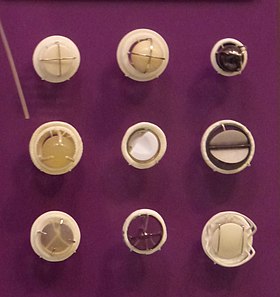
Back صمام قلبي اصطناعي Arabic Herzklappenersatz German Prótesis valvular cardíaca Spanish Bioprothèse valvulaire French מסתם לב מלאכותי HE Protesi valvolare cardiaca Italian 人工心臓弁 Japanese Sztuczna zastawka serca Polish Искусственный клапан сердца Russian Umetna srčna zaklopka Slovenian
This article needs more reliable medical references for verification or relies too heavily on primary sources. (January 2022) |  |
| Artificial heart valve | |
|---|---|
 Different types of artificial heart valves[1] | |
| Specialty | Cardiology |
An artificial heart valve is a one-way valve implanted into a person's heart to replace a heart valve that is not functioning properly (valvular heart disease). Artificial heart valves can be separated into three broad classes: mechanical heart valves, bioprosthetic tissue valves and engineered tissue valves.
The human heart contains four valves: tricuspid valve, pulmonary valve, mitral valve and aortic valve. Their main purpose is to keep blood flowing in the proper direction through the heart, and from the heart into the major blood vessels connected to it (the pulmonary artery and the aorta). Heart valves can malfunction for a variety of reasons, which can impede the flow of blood through the valve (stenosis) and/or let blood flow backwards through the valve (regurgitation). Both processes put strain on the heart and may lead to serious problems, including heart failure. While some dysfunctional valves can be treated with drugs or repaired, others need to be replaced with an artificial valve.[2]
- ^ Kostrzewa B, Rybak Z (2013). "[History, present and future of biomaterials used for artificial heart valves]". Polimery W Medycynie. 43 (3): 183–9. PMID 24377185.
- ^ Baumgartner H, Falk V, Bax JJ, De Bonis M, Hamm C, Holm PJ, et al. (September 2017). "2017 ESC/EACTS Guidelines for the management of valvular heart disease" (PDF). European Heart Journal. 38 (36): 2739–2791. doi:10.1093/eurheartj/ehx391. PMID 28886619.